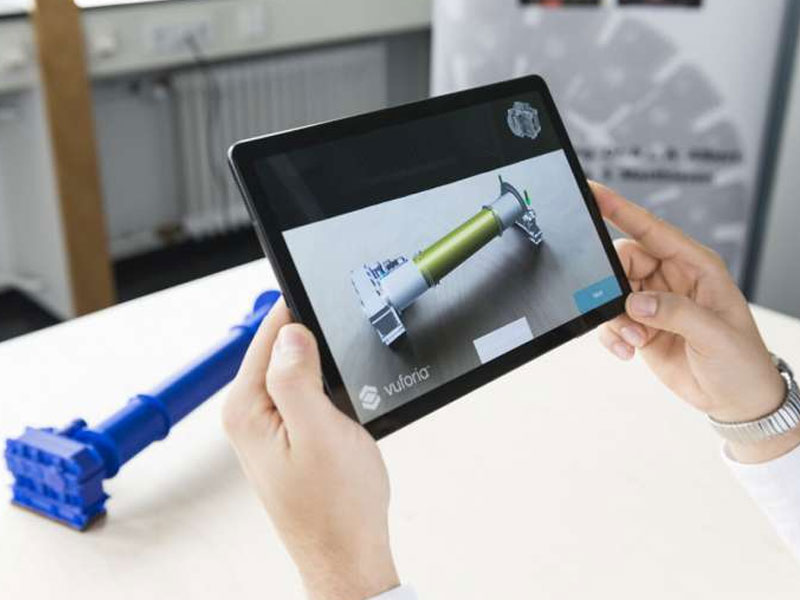Virtual reality helps people with hoarding disorder practice decluttering
SOURCE: HTTPS://WWW.SCIENCEDAILY.COM/
OCT 16, 2023
Learning from game developers: Product development with extended reality
SOURCE: TECHXPLORE.COM
SEP 29, 2021

Physico-virtual prototypes of components can be changed by a few clicks on the screen. Credit: Laila Tkotz, KIT
Can my product do what it is supposed to do and will the customers buy it? The answer will decide on the success or failure of commercialization. The problem: We do not know it prior to the launch of the product. The solution: Instead of building expensive prototypes of cars, devices or machine components, companies can use virtual models in very early development phases to find out whether a new product will be attractive to customers in terms of design and operation. For this purpose, researchers of Karlsruhe Institute of Technology (KIT) develop new methods and processes for direct use in engineering and education.
"In automotive industry, ten percent of the total development budget are often spent for the production of prototypes," says Marc Etri, Head of the XR Lab at KIT's Institute of Product Engineering (IPEK). "This may easily result in several million euros." Scientists of IPEK now work on reducing these expenses by using extended reality (XR). These are computer technologies that extend the physical environment by virtual components (augmented reality, AR) or replace it completely (virtual reality, VR).
"In all development phases, from finding product profiles to producing concepts to detailing and implementing them, XR technologies make it easier to adapt products to wishes of customers and market requirements," Etri explains. "Physico-virtual prototypes help save development time and costs and prevent errors that will often be detected in later development phases only." As an example, he presents the photorealistic three-dimensional model of a racing bike that can be edited on the tablet. "I can change the design of the wheels, frame, or saddle by one click only." Details, such as the color or gloss level of the seat post or the structure of the seat cover can also be modified by a few clicks. The sharpness of detail reached by the program is demonstrated by a watch: Even photographic phenomena, such as reflection on the housing glass, vary for different designs as a function of real illumination.
"Many engineers in practice do not even know what is possible with AR and VR," says Professor Albert Albers, Head of IPEK. "Game developers demonstrated the potentials long ago," Etri adds with a view to the highly popular blockbusters in the gaming sector and their powerful images. Often, up-to-date, customer-oriented product engineering fails due to non-standardized data management by the departments or partner companies involved and the resulting lack of consistency, Albers points out. "We cannot develop solutions of the 21st century using methods of the 20th century." Engineering can largely benefit from new technologies and methods, even more so during the current pandemic. "These technologies also enable contact-free work across locations," Albers adds.
The Extended Reality Lab in KIT's academic education
The XR Lab is used for fundamental research projects and projects with companies as well as in academic education. "Last winter semester, machine design lessons for the first time included virtual reality exercises," Etri says. "About 400 first-semester students of mechanical, biological, and chemical engineering as well as of mechatronics were familiarized with the potentials of XR technologies in product engineering." According to Etri, the students as digital natives will find it easy to use these technologies. "This will strongly influence their engineering tools preferred during later work."
LATEST NEWS
Augmented Reality
Hi-tech smart glasses connecting rural and remote aged care residents to clinicians
NOV 20, 2023
WHAT'S TRENDING


Data Science
5 Imaginative Data Science Projects That Can Make Your Portfolio Stand Out
OCT 05, 2022

SOURCE: HTTPS://WWW.SCIENCEDAILY.COM/
OCT 16, 2023
SOURCE: HTTPS://WWW.SCIENCEDAILY.COM/
OCT 16, 2023
SOURCE: HTTPS://WWW.MOBIHEALTHNEWS.COM/
AUG 28, 2023
SOURCE: HTTPS://WWW.SCIENCEDAILY.COM/
AUG 07, 2023
SOURCE: HTTPS://WWW.SCIENCEDAILY.COM/
JUL 14, 2023
SOURCE: HTTPS://WWW.SCIENCEDAILY.COM/
JUL 13, 2023
SOURCE: HTTPS://WWW.ANALYTICSINSIGHT.NET/
JUN 21, 2023